
How to Build Muscle—Beginner Guide for Women
We’ve written a full guide on how to build muscle on Outlift, but we wanted to write an article specifically for women. After all, women often have different muscle-building goals, benefit from different exercises, and tend to have different questions.
If you’re just beginning, building muscle can be exciting but also daunting. You need to challenge your muscles and eat enough food to support muscle growth. That sounds so simple, but how do you do it? What exercises should you do, and in what order? How hard should you push yourself, and how often? And what should you eat, and how much of it?
For example, some styles of workouts are better for stimulating muscle growth than others. Strength training will challenge your muscles, but it’s designed to help you contract your muscles more forcefully, making you stronger for your size. It’s not designed to help you build muscle, making you bigger and stronger. There’s nuance here.
Inside, we’ll cover everything a woman ought to know about working out, nutrition, and recovery.
- The Big Picture
- Can All Women Build Muscle?
- Do Women Build Muscle Differently?
- Building a Woman’s Muscle-Building Plan
- Setting Realistic Goals
- Basic Lifting Definitions
- Women Can Build Muscle At Home Or The Gym
- Selecting The Right Style Of Workout
- Selecting the Right Exercises
- Establishing a Workout Routine
- How To Select The Right Weight
- How To Know If You Should Go To Failure
- How To Lift With Good Technique
- The Right Amount Of Rest Between Sets
- Beginner Muscle-Growth Workout Routine For Women
- A Womanly Bulking Diet
- The Best Muscle-Building Supplements for Women
- Recovery and Rest
- What Next?
The Big Picture
Muscle is built on a foundation of three pillars—you need to challenge your muscles (lift enough), eat enough food to fuel muscle growth (eat enough), and give your muscles time to repair and grow (rest enough).
The Three Pillars Of Muscle Growth
That gives you a clear sequence to follow:
- Lift enough: if you start eating and resting more before you stimulate muscle growth, around 2/3 of the weight you gain will be fat. To stimulate muscle growth, you need to challenge your muscles. The best way to challenge your muscles is with resistance training. There are a few different types of resistance training. You can lift weights, such as with barbells and dumbbells, use exercise machines, or do bodyweight workouts. In a pinch, you could even use resistance bands.
- Eat enough: once you’ve started working out, you can start tweaking your diet. Muscle is made out of protein, and most women (and men, for that matter) don’t eat nearly enough protein to maximize their rate of muscle growth. You probably need more. And if you’re a skinny or lean woman, the energy needed to create extra muscle mass will need to come from the food you’re eating, so you’ll also need to eat in a calorie surplus. Women with higher body fat levels won’t need to be in calorie surplus as they’ll have enough energy to work with (but they’ll still need lots of protein.)
- Rest enough: once you’ve started working out and eating enough good food, recovery is the next thing to consider. It can be tempting to exercise every day, blast your muscles as hard as you can, and spend all your motivation on doing more. But it’s when you’re resting that your muscles will grow. You need to wait. And while you wait, the best thing you can do for your muscles is to get enough sleep. If you get enough good sleep each night, you’ll gain way less fat and much more muscle. Getting good sleep is one of the most powerful things you can do for muscle growth. And it’s healthy, too.
Building muscle comes down to these three “pillars.” We call them pillars because you need all three to consistently build muscle. You can’t stimulate muscle growth without training, you can’t build muscle without eating enough food, and you can’t outlift yourself without enough rest between workouts.
Can All Women Build Muscle?
Your genetics play a significant role in your muscle growth potential. Some women have naturally thicker bones, bigger muscles, and larger appetites, all of which make them naturally more muscular.
Some women are starting in better cardiovascular shape and can handle more intense workout routines, doing more exercises with shorter rest times. Other women need to ease into working out.
We’ve helped over 3,500 women build muscle. It works on everyone, guaranteed. But it also looks different on everyone. You can’t pick your favourite influencer and build their body. You have to build your own body, becoming the best version of yourself.
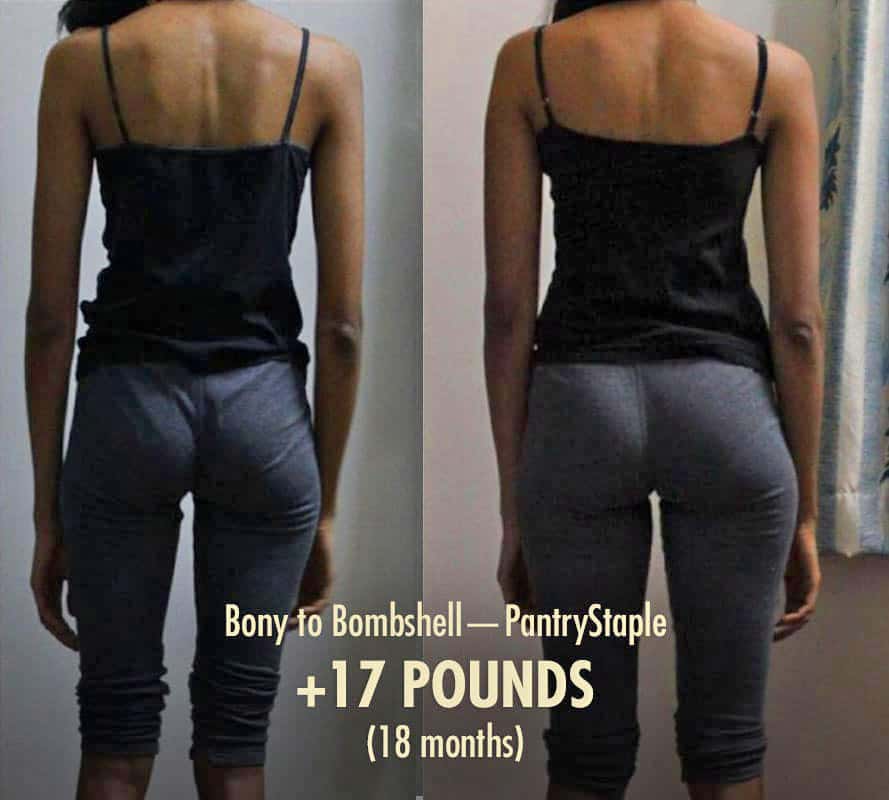
Do Women Build Muscle Differently?
How Female Hormones Affect Muscle Growth
It’s commonly thought that men can achieve higher rates of muscle growth due to their naturally higher testosterone levels. That doesn’t seem to be true. Rather, it seems that men can build more muscle because they begin with more muscle and have larger frames to fill out.
Testosterone is a chemical messenger for the body, and it plays a role in muscle protein synthesis, which is crucial for muscle growth. However, women produce all the testosterone their need in their ovaries. You don’t need to worry about it. Just focus on living a generally healthy lifestyle: exercise, eat enough nutritious food, and get enough good rest (when possible).
The other consideration is that many women’s hormones fluctuate quite dramatically throughout the month. This has led some people to believe they should be training differently at different times of the month. It’s true that your energy and motivation might fluctuate, but your training shouldn’t change. If you challenge yourself every workout, you can build muscle steadily all month long (study).
Female Muscle Proportions & Goals
Women tend to have different bone structures, shaped less like Doritos and more like hourglasses. Women tend to have more lower-body strength than upper-body strength. Your grip strength and bench press might be much lower than your husband’s, which is why he can open all those damn jars. But your lower-body strength is formidable. You can build an impressive squat, Romanian deadlift, and hip thrust.
This is exacerbated by the fact that most women want curvier lower bodies, whereas most men want thicker upper bodies. Most men spend their workouts lifting dumbbells overhead and doing bicep curls. Meanwhile, most women spend their time doing squats, lunges, deadlifts, and hip thrusts. This creates even more sexual dimorphism.

For example, women are often better off focusing on push-ups than the bench press. Their body weight is more than heaving enough to challenge their pushing muscles. The bench press is rarely needed.
For another example, most women are more eager to bulk up their lower bodies, so it makes more sense to invest more effort into squats, deadlifts, and hip thrusts. Mind you, goals are highly individual, and your goals may change with time.
Cassandra started off wanting a toned stomach, then wanted a curvier lower body, then stronger arms. You can focus on several things at once, and you can adopt new goals as you vanquish old ones.
Still, women usually prefer workout programs designed specifically for women. That’s why we wanted to make this whole separate article.
Building a Woman’s Muscle-Building Plan
Setting Realistic Goals
First, you’ve got to set realistic and tangible goals. Are you a beginner, intermediate, or advanced lifter? A common mistake is for beginners to follow advanced workout routines because they assume more is better. That’s not true. Doing enough yields more muscle growth than doing too much.
If you’re a beginner, you might be surprised how little work it takes to maximize your rate of muscle growth. Even short workouts can leave you sore for days. Doing more would only cripple you, hindering your performance and slowing you down.
You might see fitness influencers training 6 days per week. Maybe you’re desperate to see progress. Maybe you’re willing to do whatever it takes. So the urge is to train every day.
In fact, most beginners get better results from doing 3 vigorous full-body workouts every week. You train all of your muscles, take a full day of rest, and then train them all again. On those rest days, you can go on walks, do cardio, do some light aerobics or yoga, or spend more time preparing food.
Basic Lifting Definitions
We’re about to dive into the deep end. Before we do, you need to know a few lifting terms.
- Repetitions. A repetition—or rep—is when you do an exercise motion once. If you squat down and then stand back up, that’s one repetition. Same with push-ups. If you lower yourself down to the ground and then push yourself back up, that’s one “rep.”
- Sets. You will do more than one rep in a row in almost every circumstance. That way, you make your muscles do more work to stimulate muscle growth. So maybe you do ten squat repetitions in a row before you rest. That’s ten repetitions. We call that group of reps a “set.”
- Volume: you will do more than one set in most workout programs. Again, the idea is to do enough work to stimulate a maximal amount of muscle growth. So maybe you do a set of squats, rest for a couple of minutes, and then do another set. That’s two sets of squats. If you’re doing two sets of squats, and each set has ten repetitions, we call that “2 sets of 10 repetitions.” We can shorten than to “2×10” when filling out a workout sheet.
If you’re training for muscle growth, you can tally up how many sets you do for each muscle. Two sets of squats are two sets for your quads and butt. If you do that three times per week, that’s six sets of volume for your quads and butt per week. That’s your weekly training “volume” for those muscles.
Women Can Build Muscle At Home Or The Gym
If you want to work out at a commercial gym, that’s great. They have everything you need. They also have energy. You’re surrounded by people working hard. You’ll be motivated to work hard, too.
But a lot of our Bombshell members train at home. There are many reasons for this—saving time, convenience, privacy, or cleanliness. Maybe it lets you sneak in a workout when your baby is napping or your kids are playing in another room.
Resistance bands are popular, but they don’t work very well. They’re especially poor for helping you build a bigger and stronger lower body. We don’t recommend them.
You could do bodyweight workouts at home. Bodyweight training works very well. But the workouts are harder, longer, and more painful.
Weights are popular for a reason. The easiest way to build muscle at home is to build a home gym. It doesn’t need to be expensive or take up much room.
You’ve got two good options:
- Barbell home gym. If you’ve got a house with a spare room, we recommend a barbell home gym. Barbells are pleasant to train with, making it super simple to progressively overload your lifts, especially the glute bridge. They’re amazing for building muscle. Here’s our full guide on how to build a barbell home gym.
- Dumbbell home gym. If you don’t have space for a barbell home gym, the next best option is to get some adjustable dumbbells. Dumbbells are great for building muscle, especially for beginners. Here’s our full guide for building a dumbbell home gym.

Training at a commercial gym gives you access to every piece of equipment. Barbell home gyms don’t have everything, but the workouts are short, efficient, and painless. Dumbbell workouts are a bit longer and harder, but they’re still just as good for building muscle.
Selecting The Right Style Of Workout
Different types of training are designed with different goals in mind. Strength training is designed to make you stronger for your size, Olympic weightlifting is designed to increase your explosive power, and hypertrophy training is designed to make your muscles bigger. There’s plenty of overlap, though. All of them will make your muscles bigger, stronger, and more powerful.
Still, if you want to focus on muscle growth, better to focus on a style of lifting called “hypertrophy training.” You’ll build muscle much faster. It’s also safe and healthy.
Before we dive deeper, there’s a miscommunication to be wary of. When most beginners say “strength training,” they’re speaking generically. They’re talking about building muscle and getting stronger. Speak to a lifter, though, and “strength training” has more to do with powerlifting—improving 1-rep strength on the squat, bench press, and deadlift in a given weight class.
There’s another term to watch out for, too—bodybuilding. Again, to most beginners, bodybuilding simply means building a bigger body in the gym. And that’s not wrong. Bodybuilders do train for muscle growth.
But bodybuilding also involves dieting down to unhealthy body fat levels (which can cause amenorrhea), spending time learning posing techniques, spray tanning your body, and sometimes abusing a cornucopia of unhealthy supplements and drugs. Bodybuilding isn’t just training for muscle size. It’s a whole thing.
“Hypertrophy training” has none of this baggage. It simply means training to build bigger muscles. No sport is associated with it, meaning it’s not tied to any specific lift, method, or posing routine. You can do the lifts that suit your body best and emphasize the muscles you’re most eager to grow. Women can keep their periods and their natural skin tone.
Selecting the Right Exercises
Your muscles respond to the stimulus you give them. If you give your leg muscles a lot of work, your legs will grow. If you give your arm muscles a lot of work, your arms will grow. As we mentioned earlier, most women choose exercises that accentuate their natural feminine curves. That means choosing exercises that hit the entire body and then giving a bit more attention to the lower body, particularly the glutes.
(You can emphasize whatever you want. We’re just suggesting defaults. Please customise everything we say to suit you even better.)
As a rule of thumb, start with big compound exercises and finish with isolation exercises. Compound exercises work many different muscles at once, creating a balanced/athletic/fit look. When you do something like a Romanian deadlift, it’s not just hitting your hamstrings and glutes. It also strengthens your muscles, improves your posture, strengthens your grip, and teaches you how to lift heavy things up from the ground.
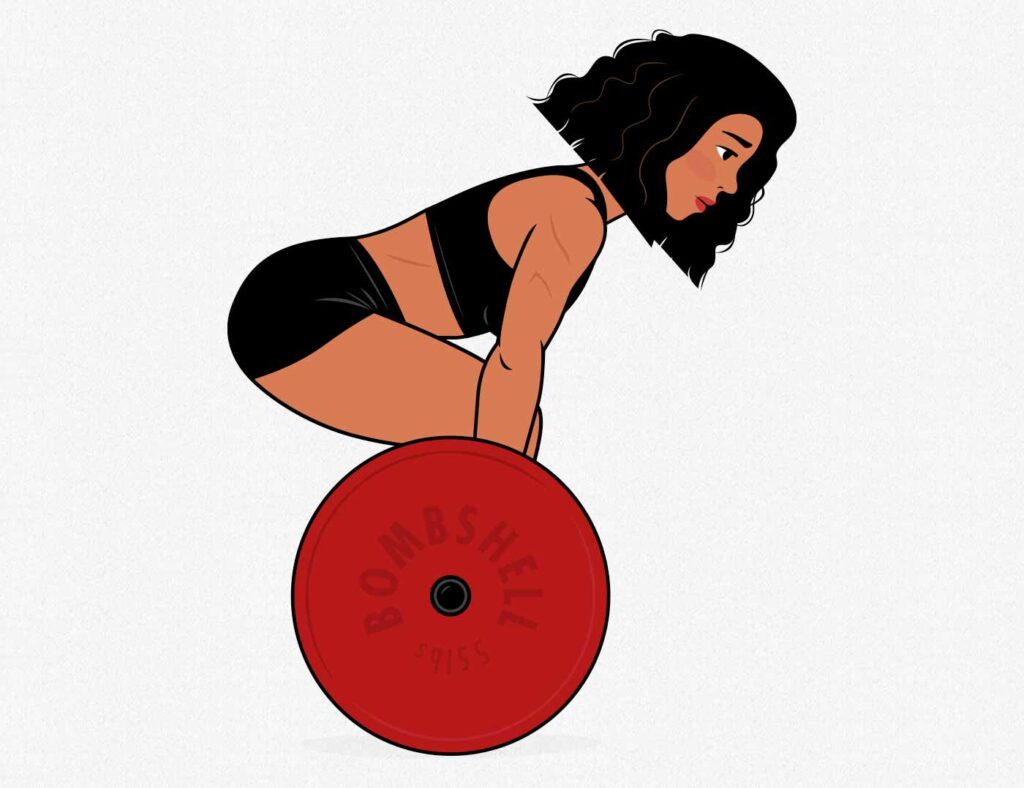
Here are the big compound lifts to focus on:
- Squat. This movement targets your quads, glutes, and hamstrings. Compound exercises include the Goblet Squat and Front Squat.
- Hinge. They engage your entire posterior chain, including your lower back, glutes, and hamstrings. Compound exercises include the Romanian Deadlift and the Kettlebell Swing.
- Push. This movement works your chest, the middle and front of your shoulders, and triceps. Compound exercises include the push-up and the bench press.
- Pulls. This movement strengthens your back, biceps, and the back of your shoulders. Compound exercises include chin-ups and dumbbell rows.
You can see extra muscle growth by following up compound exercises with a bit more attention by doing some “isolation” exercises. These are simpler exercises that usually work a single joint. You can do these exercises to catch up with any small lagging muscles or if you want to emphasize certain muscles over others (like your glutes.)
- Glutes. Glute bridges, hip thrusts, donkey kicks, etc.
- Quads. Step-ups, leg extensions, leg press, hack squat, etc.
- Hamstrings. Pull-throughs, leg curls, etc.
- Calves. Calf raises.
- Abs & Obliques. Flutter kicks, Russian Twists, etc.
- Biceps. Biceps curls, hammer curls, etc.
- Triceps. Overhead tricep extension, tricep kickbacks, etc.
- Shoulders. Lateral raises, upright rows, etc.
Establishing a Workout Routine
When looking at a workout, there are a few things to pay attention to make sure you see consistent progress allowing you to stay motivated:
- Lifting Frequency: Aim for 3 workouts per week, allowing for one day of rest between each workout. For example, Monday–Wednesday–Friday.
- Effort: Bring your muscles to the cusp of failure. To challenge your muscles, you need to work them hard with the right weight. Try to get as many reps as you can. If you think you might be able to get another one, give it a try. If you fail to lift the weight up, stop just shy of failure next time.
- Volume: Volume is the total amount of sets per week for each muscle group. In general, you want to do the least amount of volume needed to see results. Increase volume when your results start to slow or plateau. A beginner might only need 1-2 sets per week to see growth, whereas an intermediate lifter will need more volume over the week to see continued growth. Sometimes you’ll see workout programs that add weekly volume to see continued strength growth.
- Progressive overload: You’ll gradually need to keep getting stronger to get continual results. That means you could do the same reps but lift more weight, keep the weight the same and do more reps, or keep the weight and reps the same and add more sets. Your workouts should continually challenge your muscles to adapt bigger and stronger.
How To Select The Right Weight
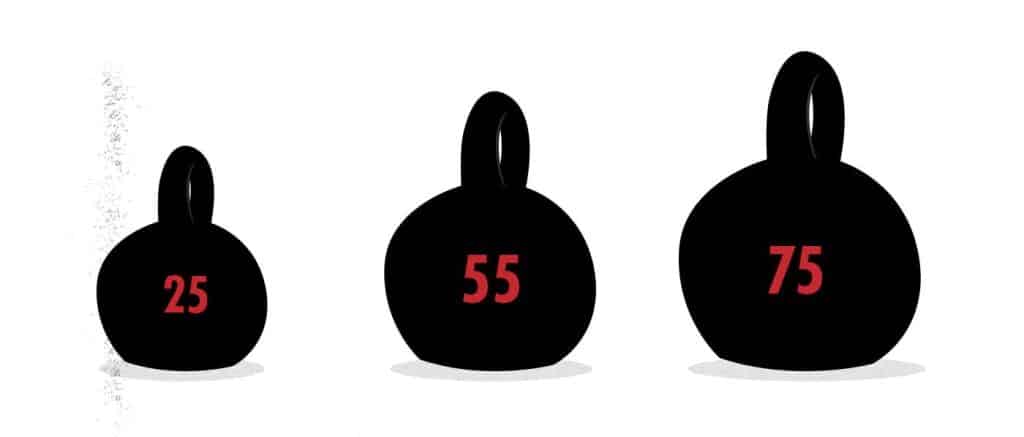
You won’t know how strong you are when you first start lifting. You’ll need to do gradually heavier warm-up sets to find your “working” weight. The bad news is it’s trial and error. There’s no magic trick or algorithm. The good news is that you need to warm up anyway, and a bit of extra practice never hurt anyone. To find the right weight:
- Grab a weight that’s much too light.
- Do 8 reps or so.
- Grab a heavier weight and warm up with that, too.
- Another 8 reps.
- And then an even heavier weight.
- 8 more reps.
Keep using heavier weights until those 8 reps start to challenge you. Now you’re getting close. Grab a heavier weight and attempt a working set. Let’s say you’re trying for 10 reps per set. If you get 10 reps, try eking out a few more. If you get a few more, you need an even heavier weight—keep moving up. You’ll know you’ve found the right when you can only do 11–12 reps with it.
You might wind up doing far too many warm-up sets on some exercises. You might also wind up accidentally hitting failure. That’s okay. The first week of a workout program is usually shorter and easier anyway. You might only have 2 working sets per exercise. Even with the extra warm-up sets, the workout won’t be that long or hard.
How To Know If You Should Go To Failure
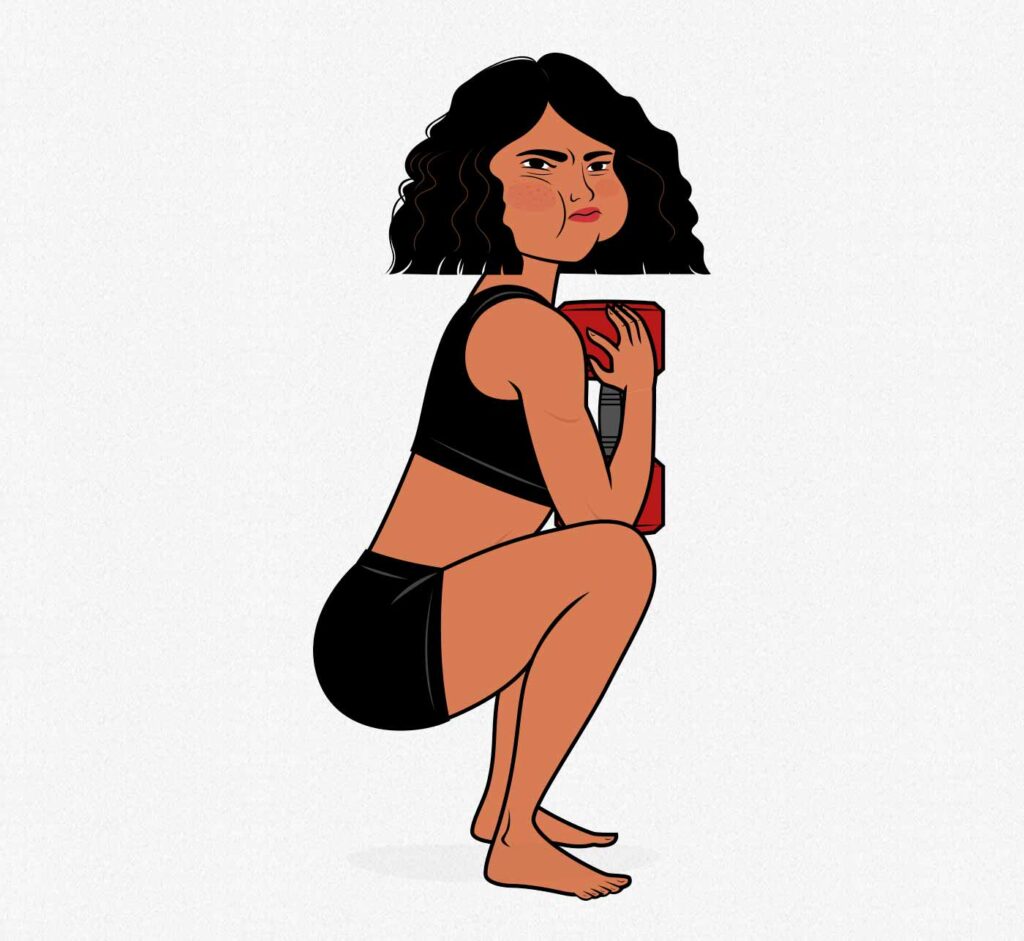
Advanced lifters are best advised to avoid taking an exercise to failure but to keep a few reps in the tank. It causes less muscle damage, generates less fatigue, and stimulates more muscle growth (study, study, study, study, study). On heavy compound lifts, like a 5-rep set of squats, that might mean stopping 1–3 reps short of failure. On a 12-rep set of push-ups, that might mean stopping a single rep shy of failure. And with biceps curls and hip thrusts, that might mean lifting until the bar won’t budge.
There’s a bit of an unfortunate truth with beginners, though. They aren’t very good at contracting their muscles yet, making it harder to stimulate muscle growth. Even on the final reps of a hard set, their muscles still aren’t fully firing. And so it turns out that beginners stimulate more muscle growth if they push all the way to muscle failure (study, study, study, study). Now, just to be clear, you can still build muscle without going to failure. But you’ll stimulate even more muscle growth if you do:
Here’s the other thing. All of these studies looked at beginners doing simple isolation lifts. Beginners are even worse at challenging their muscles with compound lifts. Beginners would need to pretty much murder themselves with the barbell to stimulate a maximal amount of muscle growth with compound lifts. That isn’t always safe and ideal for learning good lifting techniques.
The good news is that you can combine compound lifts with isolation lifts to get the best of both worlds. Start your workouts with your compound lifts, stopping just before your form begins to break down. Maybe that’s a rep or three shy of actual muscle failure.
Then, with your isolation lifts, go all the way to failure, at least sometimes. You don’t need to take every set to failure. But on the final sets of your isolation lifts, lifting to failure is a good way to stimulate some extra muscle growth.
Maybe that means stopping your goblet squats before your back starts to cave in, then doing 2–3 sets of glute bridges to push your glutes even harder. Then, on the final set of glute bridges, you go all the way to total muscular failure. That way, you’re getting better at goblet squats and maximizing your rate of muscle growth.
You’re engaging more overall muscle mass with your compound lifts, but you’re relying on your isolation lifts to truly challenge your target muscles. That’s how beginners can build muscle at full speed.
How To Lift With Good Technique
Cautious people tend to focus on lifting with great technique. The problem is, becoming good at something takes practice. It’s a physical thing; you can’t overthink it. So, no matter how hard they try, beginners can’t lift with great technique. And so, for fear of getting hurt, careful people tend to lift light weights slowly. But that isn’t enough to challenge their muscles. They don’t get hurt but don’t accomplish much, either.
Bold people tend to focus on challenging and pushing themselves. If someone is always focusing on lifting more weight, they’ll be tempted to heave, swing, and cut the range of motion short. They jerk the weights around like furious hairless apes. This doesn’t always hurt them, but it can. Perhaps a bigger problem is that reckless people never learn to lift gracefully.
To build muscle, you want the best of both worlds. You want to lift as deep as you can manage, to get gradually better over time, and to push yourself. But it will take practice. It’s okay if your technique is bad at first. We’ve all been there.
Consider a toddler learning to walk. They aren’t graceful yet, but if they keep trying, they will be. Your job is to encourage them to push themselves, rewarding them for their awkward successes. Give your imperfect self that same love and support.
Keep in mind that most beginner lifts are pretty safe. Taking a set of goblet squats all the way to failure just means guiding the dumbbell back down to the floor. No harm done… unless you lose your grip and drop the dumbbell on your toe. (Don’t do that.)
So don’t be afraid of taking some of your compound lifts to failure now and then just to see how far away failure is. Trial and error is the only way to learn how close to failure you’re lifting.
The Right Amount Of Rest Between Sets
Rest times don’t matter that much, and beginners don’t need to rest that long between sets anyway. The idea is to rest long enough to get another good set in. You know you haven’t rested long enough if you get 10 reps in your first set and 4 in your second. But if you get 10 reps in your first set and 8–9 reps in your second, that’s good.
For beginners, 1–2 minutes is enough. If you’re in a hurry or keen to improve your fitness, you can time your rest periods. 2 minutes for big compound lifts like squats, push-ups, Romanian deadlifts, and rows. One minute for smaller lifts like glute bridges, lateral raises, planks, and hip thrusts. If you aren’t in a hurry, you can wait until your heart rate settles down and you’re ready to lift again. Just try not to get too distracted between sets, or your workouts might start to drag.
You can also pair exercises together in little circuits to cut down on your rest times, keep your heart rate a bit higher, and still give your muscles enough time to recover between sets. To do that, you’d alternate between different exercises. Here’s how that might look:
Circuit 1—Squat + Row
- Goblet squats, rest 1 minute
- Dumbbell row, rest 1 minute
- Goblet squats, rest 1 minute
- Dumbbell row, rest 1 minute
Circuit 2—Hinge + Push
- Romanian deadlifts, rest 1 minute
- Push-ups, rest 1 minute
- Romanian deadlifts, rest 1 minute
- Push-ups, rest 1 minute
Circuit 3—Giant Set For Your Glutes
- Glute bridge, rest 30 seconds
- Clamshells, rest 30 seconds
- Glute Bridge, rest 30 seconds
- Clamshells, rest 30 seconds
This full-body circuit workout will take about half as long as a regular workout while stimulating just as much muscle growth. It’s also great for your general fitness.
If you’re doing circuits, the trick is to alternate between exercises that don’t train the same muscle groups. It also helps to choose exercises that can be done without using too much equipment. For instance, to do Romanian deadlifts and push-ups, all you need is the dumbbells or barbells for the Romanian deadlifts, and you can do push-ups next to that weight.
For more, we have a full article on rest times. There’s some nuance to it. Short rest times can be better for bodybuilding “pump” training, whereas longer rest times can be good for strength training and progressive overload. Both have their place in a good muscle-building workout program.
Beginner Muscle-Growth Workout Routine For Women
For example, here’s a simple beginner workout routine (with exercise demonstration videos) for a woman who wants to get stronger overall, build a bigger butt, and improve her appearance.
Workout 1
Goblet squats: 3 sets of 10 repetitions (3×10)
Dumbbell rows: 3×10
Raised push-ups: 3 sets of as many reps as possible (AMRAP)
Dumbbell Romanian deadlifts: 3×10
Bodyweight hip thrusts: 3×AMRAP
Lateral raises: 2×20
Workout 2
Goblet squats: 3×10
Underhand Lat pulldowns*: 3×10
If you’re strong enough, you can start with lowered chin-ups or even full chin-ups. Otherwise, spend a few weeks doing rows and pulldowns first. That will develop the strength you need to do chin-ups later.
Raised push-ups: 3 sets of as many reps as possible (AMRAP)
Dumbbell Romanian deadlifts: 3×10
Bodyweight hip thrusts: 3×AMRAP
Front planks: 2 sets
Side Planks: 2 sets
Try to hold the planks slightly longer than your last workout.
Front and side planks are great for teaching beginners how to maintain a strong posture while lifting, and they’re a good way to build bigger abs and obliques. But you can swap them these two lifts out for any isolation lift. For example, if you want to build thicker legs, you could do leg curls and extensions. If you want bigger glutes, you could do clamshells and donkey kicks.
Workout 3
- Goblet squats: 3×10
- Dumbbell rows: 3×10
- Raised push-ups: 3×AMRAP
- Romanian deadlifts: 3×10
- Bodyweight hip thrusts: 3×AMRAP
- Lateral raises: 2×20
Free Female Full-Body Workout Spreadsheet
GET THE GOOGLE SPREADSHEET OF THE
FREE female BEGINNER’S FULL-BODY WORKOUT
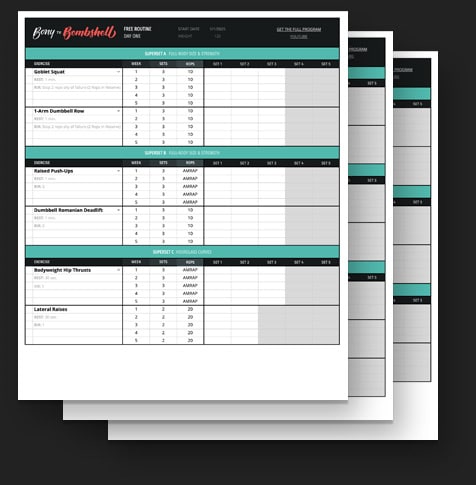
Get the workout as a Google spreadsheet. You’ll be able to pick from exercise alternatives, fill out the sheet, and get our beginner’s warm-up.
Plus, we’ll make sure you’re on the Bony to Bombshell newsletter, and send you all of our best women's muscle-building content.
Monitoring Progress and Avoiding Plateaus
You’ll need to track your progress and make adjustments when necessary to get results. Here are some tips to help you avoid plateaus and stay on track:
- Fill out your workouts. Maintain a workout log with spreadsheets to document your exercises, weights used, and repetitions completed. Use this data to know when you need to tweak your workouts.
- Progression and variety. This involves changing your rep ranges, volume (weekly sets), and exercises to keep challenging your muscles to adapt. For example, try changing your workout routine every 5-6 weeks to challenge your muscles in new ways.
- Set realistic goals. Make short-term and long-term goals to help keep you motivated and focused on your muscle growth journey.
- Take measurements and photos. Weigh yourself weekly, and take monthly body part measurements and photos to see how things are going.
Your dream goals might take persistent effort over a long time. On the other hand, you should see some noticeable results fairly quickly. Those early results will accumulate week by week, month by month.
If your weight or measurements haven’t changed in 4 weeks, chances are they won’t change in another 4 weeks. You must adjust something—either with your workouts or your diet. To get longterm results, make sure you’re getting short-term results.
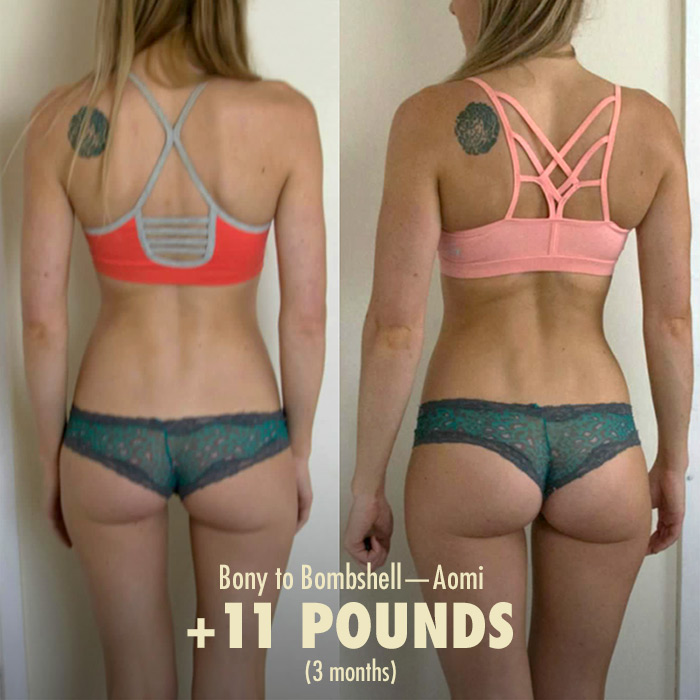
A Womanly Bulking Diet
Your workout can only stimulate muscle growth. Now you need to eat enough to allow your body to rebuild those muscles and make them bigger for next time. In this section, we will discuss protein intake for women, optimizing carbohydrate and fat intake, and the importance of vitamins and minerals.
Can Women Build Muscle Without Gaining Weight?
Some women can build muscle without gaining weight. In fact, if you’re overweight and new to lifting weights, you can probably build muscle while losing weight. If you’re skinny, muscular, or lean, you’ll probably need to gain weight to build a noticeable amount of muscle.
If you’re an overweight beginner, you don’t necessarily need to focus on calories yet. You could start by making sure you’re eating enough protein. After that, just try to make good food choices. More whole foods, fewer processed foods. More meat, poultry, eggs, fish, dairy, legumes, fruits, veggies, Greek yogurt, kefir, seeds, and nuts. Less oil, butter, sugar, soda, juice, and junk food.
If you want a specific goal, aim to get 80% of your calories from whole foods. That’s usually enough to get all the vitamins, minerals, fibre, and phytonutrients you need to build and maintain a strong body.
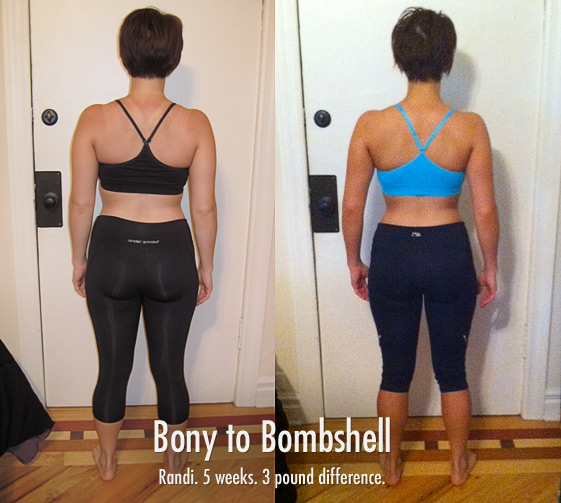
If you’re a skinny, muscular, or lean woman, you’ll need to gain weight to gain noticeable muscle size and strength. If you aren’t carrying lots of extra fat, your body won’t burn your body fat to build muscle. It wants that fat. You’ll need to gain weight to gain muscle.
Plus, if your goal weight is heavier than you are now, you need to gain weight to get there. As a man, when I was skinny at 130 pounds, the only way to get up to 190 pounds was to gain weight. I couldn’t make any progress until I learned how to eat more food. I had to eat bigger to get bigger. Just don’t rush it.
The Best Calorie Surplus for Women
How big should your calorie surplus be? And how fast should you gain weight with that surplus? As a rule of thumb, gaining around 0.25–0.75 pound per week allows you to build muscle fairly fast while keeping your gains quite lean (systematic review).
We can do a bit better than that, too. Many skinny women can gain muscle even faster, gaining as much as 0.5–1 pound per week without showing much fat gain. We often see the same thing when helping our members bulk up:

Then, as you build more muscle, you’ll get closer to your genetic potential, and your rate of muscle growth will slow. So for intermediate female lifters who have already gained their first 10 pounds, a better rule of thumb is to gain 0.25–0.5 pounds per week.
How To Get Into A Calorie Surplus For Women
There are three main ways you can get into a calorie surplus:
- Calorie counting: using your body weight and activity levels, you can loosely estimate how many calories it will take for you to gain weight. This works best for meticulous women who like tracking their diets. We’re affiliated with MacroFactor. It’s by far the best calorie tracker for building muscle and gaining weight. You can get an extended free trial with the code “b2b”.
- Adding calories: it takes roughly 250 extra calories per day to gain half a pound per week. Therefore, you can gear into bulking by adding 250 calories to the diet that you normally eat. This works well for women who eat similar meals every day as part of their routine, giving them a stable base to build upon. The trick is to make sure you keep up with your regular meals even as the awful sense of fullness pervades your life. This is how I bulk now, as a dad who lives on a schedule. I prefer it to tracking calories. But it may not be the best fit for women who like to have a lot of variety in what they eat, and, therefore a bigger variety of daily calorie intake.
- Eating 10–15% more: if you don’t want to think about calories at all, you can simply think about eating more. Increasing the size of your meals by 10–15% will get you into a reasonable calorie surplus. Again, this works best if your diet is fairly consistent from day to day. This is how most women who are into lifting as a hobby do it. Bulking is an excuse to eat more. However, skinny girls often struggle with this method.
Choose whichever method you prefer, and don’t worry too much about being perfectly precise. It’s common for beginners to get hung up here, trying to calculate exactly how many calories they’ll burn.
The truth is, no calculation, no matter how complex, is accurate enough to be all that useful in terms of accuracy. This is just a starting point. The sooner you start, the sooner you can refine what you’re doing.
How to Adjust Your Calorie Intake For Women
A common beginner mistake is to fail to gain weight, assume your initial calorie estimates are off, and then go back to the drawing board, redoing those initial calculations. That’s the wrong approach. If you aren’t gaining weight, you aren’t eating enough calories. You need to add calories to what you’re already eating. Build on what you have.
Whatever method you choose, the most important thing is to adjust your daily calorie intake based on how much weight you gain each week.
- If you’re not gaining weight, add 100–200 calories.
- If you’re gaining weight too fast, remove 100–200 calories.
For example, if you weigh 120 pounds and start by eating 2,400 calories per day, perhaps your Hellish metabolism is not so easily overcome, and you find yourself failing to gain weight. That isn’t a flaw of the formula; it doesn’t mean you’re doomed to stay under-muscled forever, and it doesn’t mean you need to retreat back to calorie formulas. All it means is that you need to add more calories.
There’s a bit of nuance here, though. Weight fluctuates quite a lot throughout the day. For women, it’s especially tricky because your weight can fluctuate over the course of the month, too. If you weigh yourself before breakfast, you might be a few pounds lighter than you are after dinner. So there are a few tricks to tracking your weight gain:
- The first week is a wildcard. Hold steady. When you first start bulking, you’re adding extra food into your digestive system, inflating your muscles full of glycogen, and adjusting to a new intake of salt in your system. As a result, it’s common to see the scale bump up by 2–3 pounds. And that’s great. There’s no need to eat fewer calories if that happens. Just ride it out for another week.
- Always weigh yourself at the same time of day, controlling for as many variables as possible. For example, weigh yourself every Sunday morning after peeing and before having anything to eat or drink. Even better if your dinner the night before is fairly consistent from week to week. (Or, for even more precision, you can weigh yourself every morning and compare your average weight every Sunday.) We recommend that our members buy their own digital weight scale to weigh themselves at the same time of the day.
- If you’re somewhat close to the ideal pace, you’re good. If you’re aiming to gain half a pound each week, but you gain 0.3 or 0.8 pounds instead, that’s perfect. Those small discrepancies are well within the realm of natural fluctuations. You don’t need to adjust by 100 calories or anything. Just hold steady. You’re doing great.
- There will come a time when your weight gain will slow. You’ll burn more calories as you get stronger, curvier, and more muscular. Gaining 10 pounds of muscle burns roughly 120 extra calories. But your body will spend calories frivolously when you’re deep into a bulk. You may notice your metabolism growing ever faster.)

How Much Protein Should Women Eat?
When trying to build muscle, a good rule of thumb is to eat at least 0.7 grams of protein per pound of body weight per day. So if you weigh 120 pounds, eat at least 85 grams of protein every day (systematic review).
You can look at nutrition labels to see how much protein is in the food you’re eating. You could also weigh your food on a food scale and look up how much protein it contains.
Another important thing is to spread your protein intake out over the day. If you can eat 3–6 meals per day, all containing at least 20 grams of protein, then you should be able to build muscle faster and leaner (systematic review).
The next question is what types of protein to eat. Fortunately, as long as you’re eating a few different sources of protein, it doesn’t matter very much. You can get your protein from:
- Seafood
- Poultry
- Red meat
- Dairy
- Eggs
- Soy
- Nuts
- Seeds
- Legumes
- Whole grains
- Peas
As we explain in our article on vegan proteins, plant-based protein sources can be great. They aren’t complete sources of protein by themselves, though, so eat a variety of them from different categories.
For instance, maybe you have 2 eggs with breakfast, some trail mix as a midmorning snack, a bowl of lentil stew for lunch, some salmon with dinner, and some Greek yogurt with frozen berries and honey before bed.

Optimizing Fat & Carbohydrate Intake
Fats and carbohydrates also significantly affect muscle growth and overall health. Having balanced macronutrients helps fuel workouts and support recovery. Here are some ways to optimize your carbohydrate and fat intake:
- Focus on easy-to-digest carbohydrates, like white rice, fruit, dried fruits, raw honey, and cooked veggies. Legumes are also a favourite.
- Include healthy fats, such as fatty fish, avocados, and nuts.
Fibre & Micronutrients
The final piece of the puzzle is making sure your diet is nutritious. To do that, we recommend eating balanced meals made primarily out of nutritious whole foods.
A balanced meal contains sources of protein, carbs, fat, and fibre. For example, you could bake a pan with salmon, potato wedges, and broccoli, all tossed in olive oil and spices. Or you could cook up a big pot of chili or lentil stew. Or mix some frozen berries and nuts into a Greek yogurt parfait.
When you’re eating balanced meals made out of whole foods, you’ll tend to get all of the vitamins, minerals and fibre you need. We go into this in more depth in our bulking diet guide. It doesn’t need to be complicated, though. You probably already have a good intuition about what a healthy diet looks like.
The Best Muscle-Building Supplements for Women
You Don’t Need Supplements
You don’t need supplements to build muscle. Their benefits are often exaggerated. Pre-workout supplements are ubiquitous among lifters despite offering little more than you’d get from a cup of coffee. You could argue that pre-workouts also boost blood flow, but you can get those exact same benefits from eating a balanced diet that’s rich in foods like beets, spinach, carrots, nuts, and garlic.
Still, there are a few supplements that can come in handy.
- Protein powders are an easy source of protein. That’s all there is to it. It isn’t better or worse than other protein sources; just more convenient. Whey protein isolate is the best default, but plant-based options are equally great, especially if you don’t do well with dairy products.
- Creatine is one of the only supplements that’s proven to increase the rate of muscle growth. It’s cheap, healthy, effective, and has been thoroughly tested for decades (systematic review).
- Caffeine gives you energy. In very high doses, caffeine can improve physiological performance, usually at the cost of your sleep and sanity. A better approach is to have a comfortable amount of caffeine to give yourself a psychological boost.
What About Weight Gainers For Women?
Weight gainers are made from protein and carbohydrate powders. They really do make it easier to gain weight. They can be good for building muscle, too. But the ingredients are heavily processed, making it more like liquid cake than a balanced meal.
If you want the benefits of a weight-gainer shake and the benefits of a balanced meal, we recommend blending up a muscle-building smoothie instead.
Sample Muscle-Building Smoothie
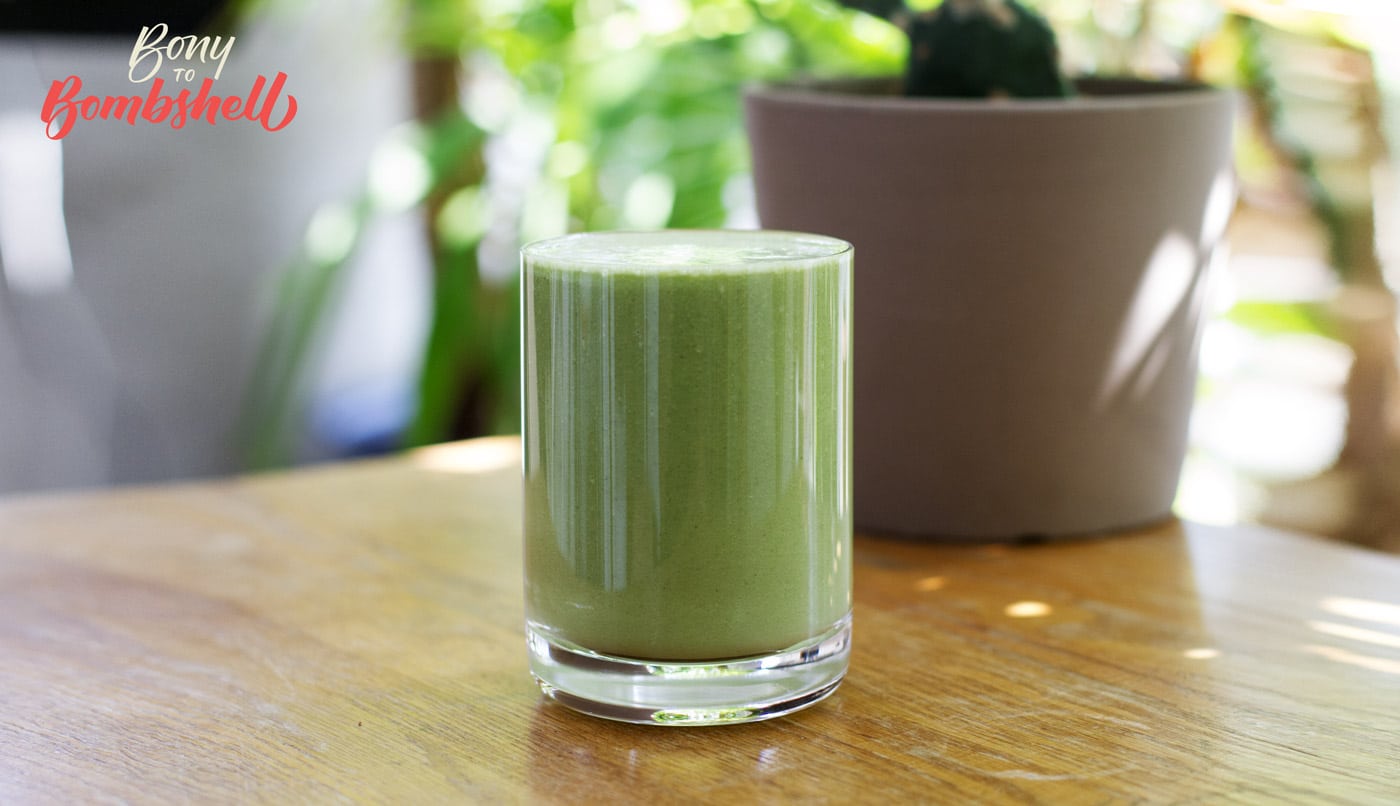
- 225ml of milk (ideally grass-fed raw that’s been tested) or plant-based milk
- 1 banana
- 1 tablespoon of almond butter
- 4 frozen strawberries
- 1 scoop of unflavoured protein powder
- A handful of fresh spinach (if uncooked greens agree with your gut)
Once it’s blended fully and smooth, add one scoop of whey isolate powder or plant-based protein powder. Like a weight gainer from supplements, it’ll be easy on your appetite. But it’ll be made of mostly whole foods that will help you feel and look better.
GET THE sample PDF recipes OF THE
weight-Gain Muscle-building Smoothies
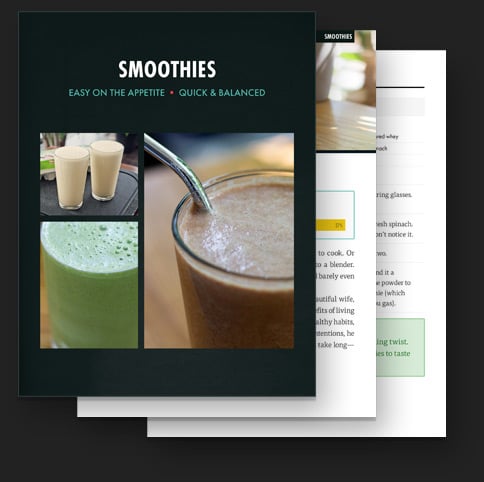
Get some sample smoothies recipes in a downloadable PDF file. Get the full explanation, ingredient list, macros, and steps to follow.
Plus, we’ll make sure you’re on the Bony to Bombshell newsletter, and send you all of our best women's muscle-building content.
Recovery and Rest
How Sleep Affects Muscle Growth (And Fat Gain)
Sleep plays a huge role in your muscle growth journey. In a study by Jabekk et al., they split 30 people up into two groups. All of them were put on a weightlifting program, but only half were given instructions on improving their sleep. Keep in mind that these were just instructions. They weren’t given medication or monitored during the night or anything. They were just told how to improve their sleep.
The weight training group did pretty well. Weight training is a powerful muscle-building stimulus. But the group that was taught how to improve their sleep gained around 30% more muscle while simultaneously losing 4 pounds of fat. This makes sleep one of the very best ways to improve your results. More muscle, less fat. It doesn’t get much better than that.
How To Improve Your Sleep

You need to focus on two aspects of sleep: length and quality. First and foremost, you need to get to bed on time. You need to give yourself enough time to sleep. Around 7–9 hours is enough for most women. If you’re unsure how much you need, better to err on the side of getting more. Go to bed 9 hours before you need to wake up. Then wake up when you feel ready for it. If you wake up before your alarm clock, great. Adjust from there.
Some women might need to be strict with their bedtimes. Maybe at 9 PM, you lower the lights. Maybe at 10, the screens go off. Maybe at 10:30, you brush your teeth and head to bed with a good novel.
Getting to bed around the same time every night establishes a steady circadian rhythm. You’ll get into the habit of waking up, eating your meals, and sleeping at the same time every day. You’ll have more energy in the morning, more of an appetite for your meals, a smoother time digesting those meals, and an easier time falling asleep at night.
Improving sleep quality is a bit trickier. The most important thing is to reduce stress, especially near your bedtime. If you’re feeling relaxed, you can slip more easily into a deep and restful slumber. Getting some sunlight in the morning can help. So can switching to dimmer, warmer lights at night.
It also helps to do something laid back in the evening, like reading an engaging novel or watching TV with your spouse. (If you watch TV, you might want to dim the backlight and/or get some amber-tinted glasses.)
Active Recovery Techniques
Incorporating active recovery techniques can help muscle growth, reduce fat gain while eating more, and reduce the risk of injury.
This is the idea that the best way to recover between workouts is to continue being at least somewhat active. It can also help to spend some time on your feet, walking around. If you go on a walk after eating a big meal, it can help with your digestion. You won’t feel as tired and sluggish. You’ll be ready to eat again sooner. That can make it much easier to keep up with your muscle-building diet.
You could, of course, do light exercise or cardio. Some people like biking, jogging, or playing sports. Those are all great options. But walking is easier. And if you’re new to working out, easier is better. Walking doesn’t require much skill, it won’t drain much willpower, and it won’t make you feel tired or sore. If anything, getting into the habit of walking should improve your overall energy levels. And it’s very, very good for your health.
Here are some goals to work towards:
- Getting at least 7500 steps per day seems to be good for general health. You could buy a pedometer and track your daily steps. You don’t have to, though.
- If you have a sedentary lifestyle, try spending 30 minutes per day walking. If you’re having trouble digesting your meals, maybe that’s a 15-minute walk after breakfast and another 15-minute walk after dinner.
If walking ever starts to feel too easy, you can always add a little weight, going rucking. Or, if you prefer, you could pick up the pace, going jogging. But until then, walking is often the best place to start.
Living A Healthy Lifestyle
Myriad other small factors can help you build muscle, most of which fall under the loose category of living a healthy lifestyle. Several things can make your lifestyle better:
- Be active, play sports, do cardio, or go on walks.
- Go outside and get some sunshine (without overdoing it).
- Manage your overall levels of stress. And if you can’t, try not to stress about it.
- Get at least 80% of your calories from whole foods.
- Eat several servings of fruits and veggies every day.
- Limit your alcohol intake to 1–2 servings most days.
- Don’t smoke (or race motorcycles.)
If you can do all these things, you might build muscle faster and leaner. They aren’t major factors, but when you add them all up, the differences might become meaningful, especially over a long time.
For instance, eating a good diet might make you feel better, improve your motivation, and give you more energy in the gym. It’s also possible that eating more veggies will give you better muscle pumps, speed up muscle growth, or reduce your rate of fat gain.
For another example, managing your stress levels might allow you to sleep better, give you more willpower, and thus help you hit your protein and calorie goals more consistently.
What Next?
To build muscle, you need to challenge your muscles (lift enough), eat enough food to fuel muscle growth (eat enough), and give your muscles time to repair and grow (rest enough). A good night’s sleep will help you consolidate your learning, replenish your energy, and keep your hormones flowing strong.
It all comes down to:
- Lift enough
- Eat enough
- Rest enough
Once you understand these principles, you just need to learn how to apply progressive overload to them. In the gym, you need to gradually lift heavier weights, wring out more reps, or use a deeper range of motion to continue challenging your growing muscles. In the kitchen, you need to gradually eat more food to continue building muscle.
If you liked this article, you’d love our muscle-building newsletter. We’ll keep you up to date on all the latest muscle-building information for women. Or, if you want us to walk you through the process of building muscle, including teaching you the lifts, giving you a full workout program, a complete diet guide, a recipe book, and online coaching, check out our Bony to Bombshell Program.

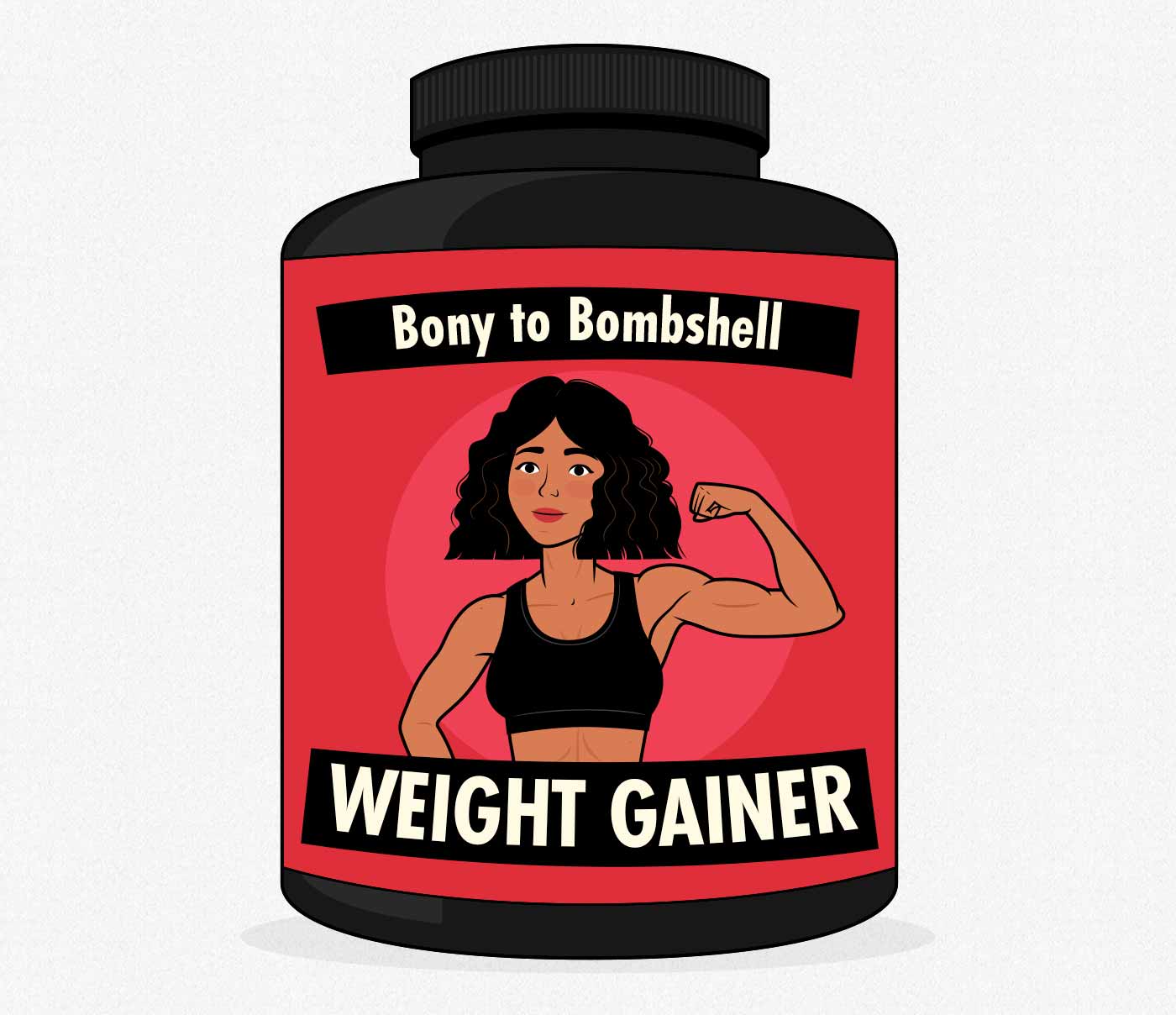



FREE women's Muscle Growth MINI-COURSE
Get our 5-part female bulking mini-course that covers everything you need to know about:
Here are some related articles